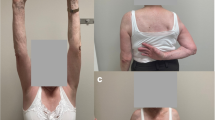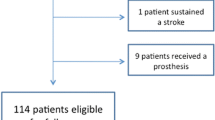Abstract
Purpose
Verify if the use of locking plates in displaced three- and four-part proximal humerus fractures has meant an improvement even in patients over 70 years of age.
Material and methods
We performed surgery with locking plate fixation in 56 consecutive patients with three- and four-part proximal humerus fractures according to Neer's classification between 1/1/15 and 12/31/20 at our Hospital. Patient satisfaction, quality of life, functionality and radiological variables, as well as the comparison between patients older and younger than 70 years were the main outcomes. Likewise, factors and complications that may have influenced these variables were analyzed as secondary outcomes. The analysis of all these variables was performed after a minimum follow-up time of 24 months after surgery.
Results
51 patients (92%) ended up satisfied or very satisfied according to the SF-36 test and with no disability or mild disability according to the DASH Score questionnaire. 46 patients (82%) obtained a satisfactory or excellent result according to the Neer scale modified by Cofield and 38 (68%) a good or excellent function according to the Constant Murley questionnaire. In 47 cases (84%) good radiological alignment was observed. Complications occurred in 20 patients (36%). The complications and the results of the SF-36, DASH Score, Neer scale modified by Cofield and Constant Murley tests depended on the radiological alignment (p = 0.009, p = 0.006, p = 0.025, p = 0.0008 and p = 0.0004). There were 37 patients younger than 70 years and 19 older than 70 years with no statistically significant differences when comparing the two groups.
Conclusions
This study demonstrates that satisfactory results can be obtained with osteosynthesis with locking plates in displaced proximal humerus fractures even in patients older than 70 years of age.
Level of evidence III
Retrospective Cohort, Treatment Study.




Similar content being viewed by others
References
Gracitelli MEC, Malavolta EA, Assunção JH, Ferreira Neto AA, Silva JS, Hernandez AJ (2017) Locking intramedullary nails versus locking plates for the treatment of proximal humerus fractures. Expert Rev Med Devices 14(9):733–739
Jabran A, Peach C, Ren L (2018) Biomechanical analysis of plate systems for proximal humerus fractures: a systematic literature review. Biomed Eng Online 17(1):47
Konrad G, Bayer J, Hepp P, Voigt C, Oestern H, Kääb M et al (2010) Open reduction and internal fixation of proximal humeral fractures with use of the locking proximal humerus plate. Surgical technique. J Bone Joint Surg Am 92(1):85–95
Schliemann B, Wähnert D, Theisen C, Herbort M, Kösters C, Raschke M et al (2015) How to enhance the stability of locking plate fixation of proximal humerus fractures? An overview of current biomechanical and clinical data. Injury 46(7):1207–1214
Schliemann B, Hartensuer R, Koch T, Theisen C, Raschke M, Kösters C et al (2015) Treatment of proximal humerus fractures with a CFR-PEEK plate: 2-year results of a prospective study and comparison to fixation with a conventional locking plate. J Shoulder Elbow Surg 24(8):1282–1288
Shukla DR, McAnany S, Pean C, Overley S, Lovy A, Parsons BO (2017) The results of tension band rotator cuff suture fixation of locked plating of displaced proximal humerus fractures. Injury 48(2):474–480
Südkamp N, Bayer J, Hepp P, Voigt C, Oestern H, Kääbe MT et al (2009) Open reduction and internal fixation of proximal humeral fractures with use of the locking proximal humerus plate. Results of a prospective, multicenter, observational study. J Bone Joint Surg Am. 91(6):1320–1328
Yang H, Li Z, Zhou F, Wang D, Zhong B (2011) A prospective clinical study of proximal humerus fractures treated with a locking proximal humerus plate. J Orthop Trauma 25(1):11–17
Koukakis A, Apostolou CD, Taneja T, Korres DS, Amini A (2006) Fixation of proximal humerus fractures using the PHILOS plate: early experience. Clin Orthop Relat Res 442:115–120
Kettler M, Biberthaler P, Braunstein V, Zeiler C, Kroetz M, Mutschler W. (2006) Die winkelstabile Osteosynthese am proximalen Humerus mit der PHILOS-Platte. Darstellung von 225 dislozierten Frakturen [Treatment of proximal humeral fractures with the PHILOS angular stable plate. Presentation of 225 cases of dislocated fractures]. Unfallchirurg. 109(12):1032–1040.
LaMartina J 2nd, Christmas KN, Simon P, Streit J, Allert J, Clark J et al (2018) Difficulty in decision making in the treatment of displaced proximal humerus fractures: the effect of uncertainty on surgical outcomes. J Shoulder Elbow Surg 27(3):470–477
Han RJ, Sing DC, Feeley BT, Ma CB, Zhang AL (2016) Proximal humerus fragility fractures: recent trends in nonoperative and operative treatment in the medicare population. J Shoulder Elbow Surg 25(2):256–261
Rangan A, Handoll H, Brealey S, Jefferson L, Keding A, Corbacho B et al (2015) Surgical vs nonsurgical treatment of adults with displaced fractures of the proximal humerus: the PROFHER randomized clinical trial. JAMA 313(10):1037–1047
Handoll HH, Keding A, Corbacho B, Brealey SD, Hewitt C, Rangan A (2017) Five-year follow-up results of the PROFHER trial comparing operative and non-operative treatment of adults with a displaced fracture of the proximal humerus. Bone Joint J 99(3):383–392
Beks RB, Ochen Y, Frima H, Smeeing DPJ, Van Der Meijden O, Timmerset TK et al (2018) Operative versus nonoperative treatment of proximal humeral fractures: a systematic review, meta-analysis, and comparison of observational studies and randomized controlled trials. J Shoulder Elbow Surg. 27(8):1526–1534
Jawa A, Yi PH, Boykin RE, Gardner MJ, Gerber C, Lorich DG et al (2015) Treatment of proximal humerus fractures: comparison of shoulder and trauma surgeons. Am J Orthop (Belle Mead NJ) 44(2):77–81
Bhat SB, Secrist ES, Austin LS, Getz CL, Krieg JC, Mehta S et al (2016) Displaced proximal humerus fractures in older patients: shoulder surgeons versus traumatologists. Orthopedics 39(3):e509–e513
Neer CS (1970) Displaced proximal humeral fractures: Part I. Classif Evaluat JBJS 52(6):1077–1089
Neer CS 2nd (2002) Four-segment classification of proximal humeral fractures: purpose and reliable use. J Shoulder Elbow Surg 11(4):389–400
Alonso J, Prieto L, Antó JM (1995) La versión española del SF-36 Health Survey (Cuestionario de Salud SF-36): un instrumento para la medida de los resultados clínicos [The Spanish version of the SF-36 Health Survey (the SF-36 health questionnaire): an instrument for measuring clinical results]. Med Clin (Barc) 104(20):771–776
Lins L, Carvalho FM (2016) SF-36 total score as a single measure of health-related quality of life: scoping review. SAGE Open Med 4:2050312116671725
Brazier JE, Harper R, Jones NM, O’Cathain A, Thomas KJ, Usherwood T (1992) Validating the SF-36 health survey questionnaire: new outcome measure for primary care. BMJ 305(6846):160–164
Jenkinson C, Coulter A, Wright L (1993) Short form 36 (SF36) health survey questionnaire: normative data for adults of working age. BMJ 306(6890):1437–1440
Hervás MT, Navarro Collado MJ, Peiró S, Rodrigo Pérez JL, López Matéu P, Martínez Tello I. Versión española del cuestionario DASH. (2006) Adaptación transcultural, fiabilidad, validez y sensibilidad a los cambios [Spanish version of the DASH questionnaire. Cross-cultural adaptation, reliability, validity and responsiveness]. Med Clin (Barc). 127(12):441–447.
Hudak PL, Amadio PC, Bombardier C. (1996) Development of an upper extremity outcome measure: the DASH (disabilities of the arm, shoulder and hand) [corrected]. The Upper Extremity Collaborative Group (UECG) [published correction appears in Am J Ind Med, 30(3):372]. Am J Ind Med. 1996;29(6):602–608.
Sperling JW, Cofield RH, Rowland CM (1998) Neer hemiarthroplasty and Neer total shoulder arthroplasty in patients fifty years old or less long-term results. J Bone Joint Surg Am 80(4):464–473
El Barra López ME (2007) Test de Constant-Murley. Una revisión de sus características Rehabilitación 41:228–235
Constant CR, Murley AH (1987) A clinical method of functional assessment of the shoulder. Clin Orthop Relat Res 214:160–164
Ranson R, Roller R, Dedhia N, Littlefield CP, Konda S, Zuckerman JD et al (2022) No change in outcome ten years following locking plate repair of displaced proximal humerus fractures. Eur J Orthop Surg Traumatol 32(6):1195–1200
Schnetzke M, Bockmeyer J, Porschke F, Studier-Fischer S, Grützner PA, Guehring T (2016) Quality of reduction influences outcome after locked-plate fixation of proximal humeral type-C fractures. J Bone Joint Surg Am 98(21):1777–1785
Olerud P, Ahrengart L, Ponzer S, Saving J, Tidermark J (2011) Internal fixation versus nonoperative treatment of displaced 3-part proximal humeral fractures in elderly patients: a randomized controlled trial. J Shoulder Elbow Surg 20(5):747–755
Shin WC, Kang SW, Son SM, Seo JS, Choi MH (2022) High bone union rate using a locking plate for proximal humeral fractures in patients older than 70 years: importance of the medial column. Eur J Trauma Emerg Surg 48(4):2937–2942
Lill H, Hepp P, Korner J, Kassi JP, Verheyden AP, Josten C et al (2003) Proximal humeral fractures: how stiff should an implant be? A comparative mechanical study with new implants in human specimens. Arch Orthop Trauma Surg 123(2–3):74–81
Tao S, Wang Q, Shi Y, Ren R, Tang B, Lu Z et al (2022) Analysis of the clinical effect of the concept of shoulder preservation in the treatment of proximal humeral fractures: a retrospective cohort study of 66 patients. Ann Palliat Med. 11(3):1077–1084
Spross C, Zeledon R, Zdravkovic V, Jost B (2017) How bone quality may influence intraoperative and early postoperative problems after angular stable open reduction-internal fixation of proximal humeral fractures. J Shoulder Elbow Surg 26(9):1566–1572
Fankhauser F, Boldin C, Schippinger G, Haunschmid C, Szyszkowitz R (2005) A new locking plate for unstable fractures of the proximal humerus. Clin Orthop Relat Res 430:176–181
Lorenz G, Schönthaler W, Huf W, Komjati M, Fialka C, Boesmueller S (2021) Complication rate after operative treatment of three- and four-part fractures of the proximal humerus: locking plate osteosynthesis versus proximal humeral nail. Eur J Trauma Emerg Surg 47(6):2055–2064
Barlow JD, Logli AL, Steinmann SP, Sems SA, Cross WW, Yuan BJ et al (2020) Locking plate fixation of proximal humerus fractures in patients older than 60 years continues to be associated with a high complication rate. J Shoulder Elbow Surg 29(8):1689–1694
Björkenheim JM, Pajarinen J, Savolainen V (2004) Internal fixation of proximal humeral fractures with a locking compression plate: a retrospective evaluation of 72 patients followed for a minimum of 1 year. Acta Orthop Scand 75(6):741–745
Yang TC, Su YP, Chang MC (2019) The elderly have similar outcomes compared to younger patients after ORIF with locking plate for comminuted proximal humerus fracture. Acta Orthop Traumatol Turc 53(1):1–5
Dey Hazra RO, Illner J, Szewczyk K et al (2022) Age-independent clinical outcome in proximal humeral fractures: 2-year results using the example of a precontoured locking plate. J Clin Med 11(2):408
Funding
There is no funding source.
Author information
Authors and Affiliations
Corresponding author
Ethics declarations
Conflict of interest
The authors declare that they have no conflict of interest.
Ethical approval
All the different phases of the work comply with the ethical standards established in the Declaration of Helsinki.
Informed consent
During the follow-up period, the patients who participated in the study expressed their oral and written informed consent for the anamnesis and physical examination, for the clinical follow-up, for the performance of complementary tests and for the surgical intervention.
Additional information
Publisher's Note
Springer Nature remains neutral with regard to jurisdictional claims in published maps and institutional affiliations.
Rights and permissions
Springer Nature or its licensor (e.g. a society or other partner) holds exclusive rights to this article under a publishing agreement with the author(s) or other rightsholder(s); author self-archiving of the accepted manuscript version of this article is solely governed by the terms of such publishing agreement and applicable law.
About this article
Cite this article
Descalzo Godoy, I., Velasco Alcalde, P., Del Olmo Galeano, A. et al. Quality of life, functional and radiological outcomes of treatment of three-part and four-part proximal humerus fractures with locking plates and comparison in young versus older than 70 years: a retrospective cohort study. Eur J Orthop Surg Traumatol 34, 415–423 (2024). https://doi.org/10.1007/s00590-023-03675-y
Received:
Accepted:
Published:
Issue Date:
DOI: https://doi.org/10.1007/s00590-023-03675-y




